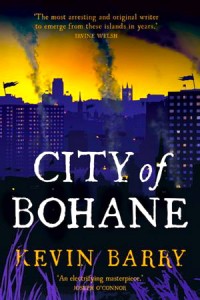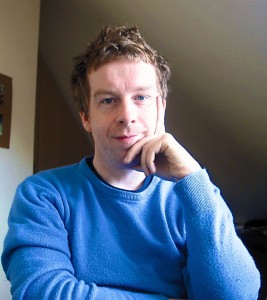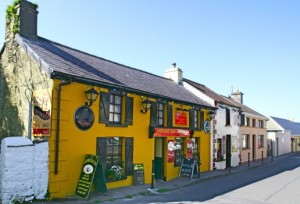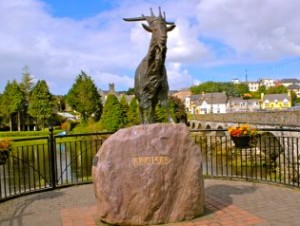“Whatever’s wrong with us is coming in off that river. No argument: the taint of badness on the city’s air is a taint off that river. This is the Bohane river we’re talking about. A blackwater surge, malevolent, it roars in off the Big Nothin’ wastes and the city was spawned by it and was named for it: city of Bohane.”
 In this imaginative and unconventional novel, Irish author Kevin Barry creates an almost feudal, fictional city in the west of Ireland in the year 2053. The novel is in no way “futuristic,” as we have come to understand that term, however, seeming instead to be a throwback to simpler pagan times in which life is seen as the rule of the strong over the weak, with vengeance and its inevitable bloodshed a way of imposing control. Bohane, a tiny city on a peninsula, overlooks the water, its day-to-day life controlled by armed gangs and their bosses. Though Sweet Baba Jay (Jesus) is often mentioned and is accepted as a living force in the lives of some of the people, their behavior and actions in their dog-eat-dog world more closely resemble the ravening hordes which swept down in pagan times to wreak havoc on weaker tribes. As Logan Hartnett, leader of one of the local gangs, says, “When you [are] running a Fancy, regular demonstrations of rage [are] needed to keep the town in check and, just as importantly, the Fancy boys in trim.”
In this imaginative and unconventional novel, Irish author Kevin Barry creates an almost feudal, fictional city in the west of Ireland in the year 2053. The novel is in no way “futuristic,” as we have come to understand that term, however, seeming instead to be a throwback to simpler pagan times in which life is seen as the rule of the strong over the weak, with vengeance and its inevitable bloodshed a way of imposing control. Bohane, a tiny city on a peninsula, overlooks the water, its day-to-day life controlled by armed gangs and their bosses. Though Sweet Baba Jay (Jesus) is often mentioned and is accepted as a living force in the lives of some of the people, their behavior and actions in their dog-eat-dog world more closely resemble the ravening hordes which swept down in pagan times to wreak havoc on weaker tribes. As Logan Hartnett, leader of one of the local gangs, says, “When you [are] running a Fancy, regular demonstrations of rage [are] needed to keep the town in check and, just as importantly, the Fancy boys in trim.”
The lack of real “civilization,” which may or may not have existed in Bohane’s past, seems to have no connection to any apocalypse, and, despite the 2053 setting (the date not revealed until page 164), the town has no technology at all – no television, no computers, no cellphones, no iPads, no internet – and no one even mentions these, suggesting they have never been introduced to Bohane. Even the one mention of “radio” refers to “wind-up transistors.” News is conveyed by newspapers for which the photographers use old Leica cameras requiring flashbulbs. Taverns selling alcoholic beverages, and coffee houses seem ubiquitous, yet they seem also to exist in a vacuum—where do supplies like flashbulbs and coffee beans come from?

Author Kevin Barry
Having turned normal expectations upside down, the author ultimately creates a strange but often exciting and darkly humorous novel about the bizarre characters who inhabit Bohane. Logan Hartnett, also called the Albino, the Long Fella, the ‘Bino, and H, is the “most ferocious power in the city,” ruling the Back Trace, “a most evil labyrinth.” He also controls Smoketown, an area which is “hoors, herb, fetish parlours, grog pits, needle alleys, dream salons, and Chinese restaurants.” His concern, however, is that the Cusacks, who live in the Northside Rises, have started to challenge his power, and he has just heard that the Gant Broderick, a man who has been gone from Bohane for twenty-five years, has now returned. Broderick was once in love with Hartnett’s wife Macu, and Hartnett is an extremely jealous man with a long memory.
The action ratchets up as two seventeen-year-old thugs, Wolfie Stanners and Fucker Burke, who work for Hartnett, casually commit murder, described in gory terms. In addition, Logan’s “girl chil’ lieutenant,” Jenni Ching, totally amoral, has the support of Girly Hartnett, the eighty-nine-year-old mother and real “backbone” of Logan Hartnett. Jenni could be a dangerous up-and-comer within the Hartnett Fancy as she begins to manipulate herself into higher positions in the hierarchy. Ol’ Boy Mannion, a born pol, is the only person in town who could be a go-between among the factions. When a Feud is declared, to much fanfare and the showing of flags and colors, all hell breaks loose. Complicating the issues is Hartnett’s enlistment of the “sandpikeys,” a group of Neanderthals led by Prince Tubby, who live at the tip of the peninsula, reviled by all.

Southwestern Irish village, probably similar to Bohane.
Author Kevin Barry creates a whole new vocabulary for his characters, and their vernacular, though sometimes challenging to translate into standard English, can usually be understood through its context: “an accent…flat and harsh along the consonants, sing-song and soupy on the vowels, betimes vaguely Caribbean.” The sand-pikeys are almost non-verbal.
In a peculiar but humorous twist, the author also concentrates throughout the novel on describing the characters’ clothing as if the novel were a fashion magazine. Logan Hartnett wore “a pale green suit, slim-cut, of thin spring cotton, a pair of burnt-orange arsekickers with a pronounced, bulbous toe, a ruffle-fronted silver shirt…a purple neckscarf.” His wife Macu donned “a pair of suede capri pants dyed to a shade approaching the dull radiance of turmeric, a ribbed black top of sheer silk that hugged her lithe frame, a wrap of golden fur cut from an Iberian lynx.” Ol’ Boy Mannion sported “high-top boots expensively clicker’d with gold taps, a pair of hip-hugging jodhpur-style pants in a faded mauve tone, an amount of gold chains, a heavy mink coat…and a goatskin beanie…” This kind of description is matched throughout the novel with capsule descriptions of the characters themselves: Gant Broderick had “a pair of hands on him the size of Belfast sinks.” Macu was “polite as the seeping of a poison,” and Wolfie had a “chick pea head.” Descriptions of places are equally vivid.

Killorglin, in Kerry, has the oldest traditional fair in Ireland. Like that town, Bohane also crowns a King Puck, a goat that is displayed on a platform during the fair.
The August Fair, which concludes the novel, superficially modeled on Puck Fairin Killorglin, is obviously skewed to appeal to the more violent and bloodthirsty characteristics of the Bohane population, resembling hell more than family fare. As characters arrive, mostly drunk, the reader is prepared for anything, and gets everything!
Kevin Barry has immense talents, and it will be interesting to see where he goes from here. The novel is chock full of unusually vivid descriptions of quirky but relatively simple characters as they engage in turf battles similar to those of most crime and Wild West novels. The confusion regarding the time of the novel and why the town feels more like 1953 than 2053, however, is strange. (I actually thought it might be a typo, instead of a gratuitous twist which adds little of significance to the novel.) The novel itself seems to be a sum of many unusual parts without an over-riding thematic structure or focus to bring it all together in the kind of resolution which echoes beyond the level of plot. Barry is a whirlwind of incredible power and unlimited imagination whose work would seem to benefit from more control.
ALSO by Kevin Barry: DARK LIES THE ISLAND (Short Stories), BEATLEBONE, NIGHT BOAT TO TANGIER
Photos, in order: The author’s photo appears on http://www.theshortreview.com
This unnamed southwestern Irish village probably has the same kind of architecture as Bohane, though it is certainly tidier than Bohane would be. http://www.irishcottageholidays.com
Killorglin, in Kerry, has the oldest traditional fair in Ireland. Like that town, Bohane also crowns a King Puck, a goat that is displayed on a platform during the fair. http://www.zazzle.co.uk
